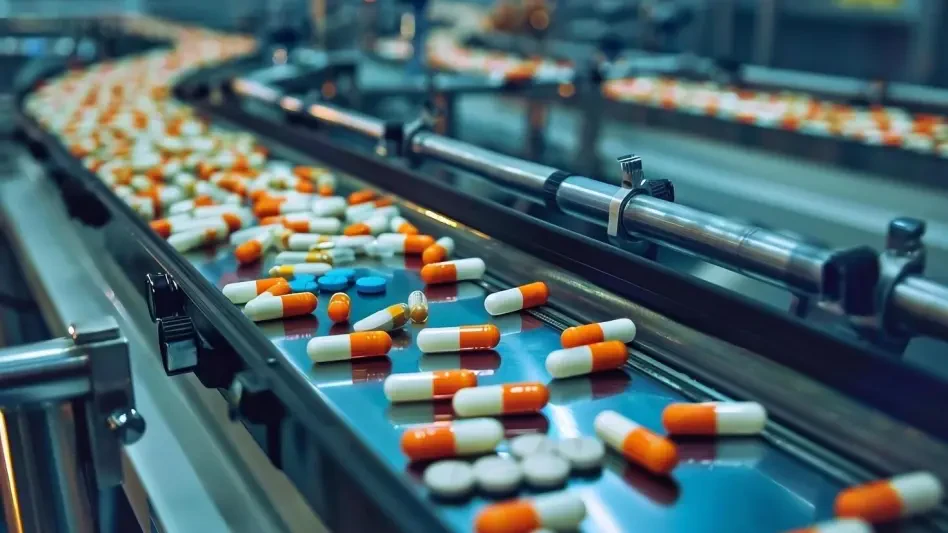The State of U.S. Pharmaceutical Manufacturing
Current Landscape and Challenges
The U.S. pharmaceutical industry stands at a critical juncture, grappling with a stark reality: over 50% of drugs and a staggering 89% of active pharmaceutical ingredients (APIs) consumed in the nation are produced overseas. This heavy reliance on foreign manufacturing, particularly from countries like China and India, exposes the supply chain to significant vulnerabilities. Domestic production capacity remains limited, with only a small fraction of critical components made on American soil, creating a bottleneck in times of crisis or geopolitical tension.
Major market players, including large pharmaceutical corporations, often depend on advanced technologies and raw materials sourced globally, further complicating efforts to localize production. The infrastructure for domestic manufacturing has not kept pace with demand, as cost advantages abroad have historically driven outsourcing. Regulatory complexities and the high initial investment required for new facilities also deter companies from establishing operations in the U.S., perpetuating the cycle of dependency.
This imbalance poses a systemic risk, as seen during recent global disruptions where shortages of essential medicines underscored the fragility of international supply chains. The challenge lies not only in capacity but also in rebuilding expertise and trust in homegrown manufacturing processes. Addressing these issues requires a concerted effort to shift the industry’s foundational structure toward self-reliance.
Importance of Domestic Production
Strengthening the domestic supply chain is not merely an economic goal but a matter of national security and public health. A robust local manufacturing base ensures access to life-saving medications during emergencies, such as pandemics or trade conflicts, when foreign supplies may be interrupted. The ability to produce critical drugs within U.S. borders mitigates the risk of shortages and enhances response times to public health crises.
Global supply chain disruptions, whether due to natural disasters or political unrest, have repeatedly highlighted the dangers of overreliance on distant production hubs. Reducing foreign dependency is imperative to safeguard the health of millions who depend on consistent access to pharmaceuticals. The urgency to build resilience in this sector has gained bipartisan support, reflecting a shared recognition of its strategic importance.
Beyond immediate health concerns, domestic production can stimulate economic growth by creating jobs and fostering innovation within the industry. Establishing a stronger manufacturing presence in the U.S. also positions the nation to set global standards for quality and safety, reinforcing its leadership in healthcare. This shift is essential for long-term stability in an increasingly unpredictable world.
Understanding the FDA PreCheck Initiative
Core Components and Objectives
Amid growing concerns over supply chain vulnerabilities, the FDA has launched a pioneering program known as FDA PreCheck to accelerate the development and certification of U.S.-based drug manufacturing facilities. This initiative aims to streamline regulatory processes, making it easier for companies to establish and operate production sites domestically. By focusing on efficiency and predictability, the program seeks to rebuild a resilient pharmaceutical supply chain within the nation’s borders.
The primary objective of FDA PreCheck is to address systemic inefficiencies that have historically hindered domestic manufacturing. Through structured guidance and support, the program encourages companies to invest in local facilities by reducing bureaucratic delays and enhancing transparency. This approach not only tackles logistical barriers but also aligns with broader goals of ensuring a steady supply of essential medicines during critical times.
Ultimately, FDA PreCheck represents a proactive step to fortify the industry against external shocks. By prioritizing domestic production, the initiative aims to create a more self-sufficient system capable of meeting national needs without reliance on foreign sources. This shift is seen as a cornerstone for enhancing both public health outcomes and national security.
Two-Phase Implementation Framework
FDA PreCheck operates through a well-defined two-phase framework designed to support manufacturers at every stage of development. The first phase, known as Facility Readiness, provides companies with direct access to FDA guidance during the planning and construction of manufacturing sites. This early interaction helps ensure that facilities meet regulatory standards from the outset, minimizing costly revisions later.
During this phase, manufacturers are encouraged to submit detailed data about their facilities, including design specifications and quality control measures, through a Type V Drug Master File (DMF). This documentation serves as a foundation for future approvals, creating a seamless transition to the next stage. The focus here is on building a strong base for compliance and operational success, tailored to the unique needs of each facility.
The second phase, Application Submission, emphasizes expedited review processes to accelerate market entry for domestically produced drugs. Pre-application meetings with FDA officials allow for early feedback on critical aspects such as Chemistry, Manufacturing, and Controls (CMC) sections of drug applications. This targeted approach reduces approval timelines, enabling faster delivery of safe and effective medications to the American public.
Addressing Barriers to Domestic Manufacturing
Key Obstacles in Onshoring Production
Bringing pharmaceutical manufacturing back to the U.S. faces numerous hurdles, spanning logistical, financial, and operational domains. High upfront costs for building state-of-the-art facilities, coupled with the need for specialized labor, present significant barriers for companies accustomed to lower expenses abroad. These financial challenges often deter investment in domestic infrastructure despite the long-term benefits.
Historically, the trend of outsourcing production has been driven by cost advantages and less stringent regulatory environments in other countries. This shift has eroded domestic expertise and capacity, making it difficult to reverse course without substantial support. Additionally, complex supply chains for raw materials, many of which are still sourced globally, complicate efforts to achieve full localization of production.
Operational challenges, such as adapting to stringent U.S. safety and environmental standards, further compound the difficulty of onshoring. Companies must navigate a maze of compliance requirements while competing with established foreign manufacturers. Overcoming these entrenched obstacles demands innovative solutions and a rethinking of traditional industry practices.
Strategies for Overcoming Hurdles
FDA PreCheck plays a pivotal role in alleviating regulatory burdens without compromising on safety or quality standards. By offering clear guidelines and expedited processes, the program reduces the uncertainty that often discourages domestic investment. This structured support helps manufacturers align with federal expectations while maintaining the integrity of their products.
Beyond regulatory assistance, federal incentives and subsidies could further encourage companies to establish U.S.-based operations. Tax breaks, grants, and other financial mechanisms can offset the high initial costs of setting up facilities, making domestic production more viable. Such measures signal a commitment to rebuilding the industry as a national priority.
Public-private collaboration also emerges as a key strategy for success. Partnerships between government agencies, industry leaders, and research institutions can drive innovation in manufacturing technologies and practices. By fostering a cooperative environment, stakeholders can collectively address challenges and build a sustainable framework for domestic drug production over the coming years.
Regulatory Context and Policy Alignment
Executive Order and Federal Priorities
FDA PreCheck aligns closely with Executive Order 14293, which focuses on promoting the domestic production of critical medicines through regulatory relief. This policy directive underscores the importance of reducing dependence on foreign supply chains as a matter of national urgency. It reflects a unified federal stance on the need to prioritize self-sufficiency in pharmaceuticals.
The broader consensus within government circles views onshoring as essential for supply chain stability and national security. Recent disruptions have exposed the risks of relying on international partners for essential drugs, prompting a reevaluation of long-standing practices. The push for domestic manufacturing is now embedded in strategic planning at the highest levels of policymaking.
This alignment with federal priorities ensures that FDA PreCheck is not an isolated effort but part of a comprehensive approach to safeguard public health. By integrating regulatory reform with overarching policy goals, the initiative gains momentum and credibility. It serves as a model for how targeted programs can address systemic issues within critical industries.
Ensuring Compliance and Quality
While FDA PreCheck seeks to streamline processes, it maintains an unwavering commitment to safety and efficacy standards. The program balances regulatory relief with rigorous oversight, ensuring that domestically produced drugs meet the same high benchmarks as their foreign counterparts. This dual focus is crucial for preserving public trust in the healthcare system.
Streamlined reviews and early guidance do not equate to lowered expectations; rather, they enable manufacturers to address potential issues proactively. The FDA’s emphasis on quality control during both phases of the program reinforces accountability at every step. This approach mitigates risks while fostering an environment conducive to rapid scaling of production.
Public confidence in domestically manufactured pharmaceuticals hinges on transparency and consistency in regulatory practices. By upholding stringent standards, FDA PreCheck ensures that the push for localization does not compromise patient safety. This balance is vital for the program’s long-term credibility and acceptance among stakeholders across the industry.
Future Outlook for Domestic Drug Manufacturing
Stakeholder Engagement and Program Development
A critical component of refining FDA PreCheck involves active engagement with stakeholders through public forums and collaborative discussions. A notable public meeting, hosted at the FDA’s White Oak Campus in Silver Spring, Maryland, with virtual access, provides an opportunity to present the draft framework and gather input. This inclusive approach ensures that diverse perspectives shape the initiative’s evolution.
Soliciting feedback from industry experts, manufacturers, and advocacy groups helps identify gaps and potential improvements in the program. Addressing real-world challenges through dialogue fosters trust and buy-in from those directly impacted by regulatory changes. Such collaboration is indispensable for crafting policies that are both practical and effective in driving domestic production.
The emphasis on stakeholder involvement signals the FDA’s commitment to adaptability and responsiveness. By integrating external insights, the agency can fine-tune PreCheck to meet emerging needs and challenges. This iterative process lays the groundwork for a robust framework that supports the industry’s transition toward greater self-reliance.
Long-Term Impacts and Innovations
Looking ahead, FDA PreCheck holds the potential to catalyze innovation in pharmaceutical manufacturing practices. By incentivizing domestic investment, the program could spur advancements in automation, sustainable production methods, and cutting-edge technologies. These developments promise to enhance efficiency and reduce costs over time, making local production more competitive.
Increased domestic capacity is also expected to diminish supply chain vulnerabilities, particularly in the face of global economic and geopolitical uncertainties. A stronger manufacturing base within the U.S. would provide a buffer against disruptions, ensuring a steady flow of critical medications. This resilience is paramount for maintaining public health in an interconnected yet unpredictable world.
The ripple effects of these changes could redefine the industry’s landscape over the next several years, from 2025 to 2030 and beyond. As more companies establish roots in the U.S., the nation could emerge as a global leader in pharmaceutical innovation and reliability. This transformation hinges on sustained support and strategic planning to fully realize the program’s vision.
Conclusion: A Step Toward Pharmaceutical Independence
Summary of FDA PreCheck’s Role
Reflecting on the journey, FDA PreCheck emerged as a pivotal mechanism to counter the longstanding trend of foreign dependency in drug manufacturing. It tackled immediate regulatory and logistical barriers through its structured two-phase approach, providing manufacturers with essential guidance and support. The initiative aligned seamlessly with national priorities, emphasizing resilience and security in the pharmaceutical sector.
The program’s design prioritized both efficiency and safety, ensuring that the push for domestic production did not compromise quality. By integrating early feedback and streamlined processes, it addressed critical pain points for industry players. This balance proved instrumental in laying a foundation for sustainable growth in local manufacturing capabilities.
Prospects and Recommendations
Looking ahead, the path forward demands sustained federal investment to maintain momentum in domestic drug production. Expanding financial incentives and fostering public-private partnerships are essential next steps to scale up infrastructure and expertise. These measures promise to bridge remaining gaps and solidify the U.S. position in the global pharmaceutical arena.
Industry collaboration also stands out as a cornerstone for future success, with ongoing dialogue among stakeholders shaping innovative solutions. Continuous engagement through public forums and policy reviews offers a way to adapt to evolving challenges. This collective effort holds the key to transforming the vision of pharmaceutical independence into a lasting reality.









